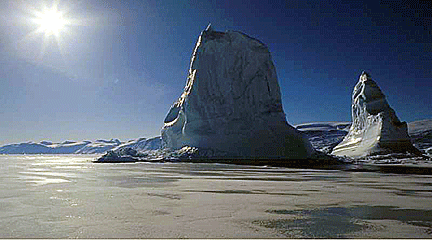Greenland—Western
Outpost of Scandinavia
by Bob
Brooke
continued...

The Danish-Norwegian king became annoyed with Dutch claims in Greenland. So in 1666 the Danes added the Greenland symbol, the polar bear, to the Danish royal coat of arms as a reminder to others to keep out. The Norwegian Hans Povelsen Egede named Royal Missionary, and backed by a Bergen trading company, established the first new settlement in 1721.
Trade rivalries and conflicts over fishing led to the declaration of a royal monopoly on trade in 1776. The purpose of the monopoly was to assure the interests of the Greenlanders in culture and trade, and many commissions and self-sacrificing administrators have done their best. Greenlanders have themselves participated in local and district advisory councils. Schools and churches and hospitals have been established. But the people remained poor. Many in both Greenland and in Denmark criticized the monopoly and the rigidity of controls as stifling to development.
By the mid- 20th century, the Danes abandoned the whole monopolistic system. They adopted free trade practices with Greenland and invited Danish investment. In 1953 Greenland ceased to be a colony and became an integral part of the Danish kingdom. This stimulated economic and political reorientation to some extent by the impact of United States soldiers and others in Greenland. Also, the climate began to moderate and the seal population, which had made possible a self-contained economy, began to decrease. The increase of cod fishing and sheep raising both required a world market. This changed basis of Greenland’s economy has been accompanied by a doubling of the population in less than 25 years.
Disputes and complications concerning sovereignty over Greenland have continued. The people of Greenland rejected the Norwegian claim in 1933. The United States, when it purchased the Danish West Indies in 1917, renounced claims to the territory discovered in the north by Admiral Perry. Then came World War II and the German occupation of Denmark. One year after that occupation, April 9, 1941, the Danish Minister in Washington, Henrik Kauffmann, signed an agreement with the U.S. Secretary of State which established a wartime protectorate over Greenland by the U.S. and permitted the U.S. to establish military and meteorological bases. But the U.S. reasserted that Denmark remained sovereign over all Greenland.
Greenland’s Importance
 The importance of this vast ice-covered island is largely strategic.
Most of the native products are of no outside significance, not even the
furs are important in world trade, though the residents dress in fox or
bearskin trousers, eat the meat, use skins for boats, and in general
live from animals. They mine coal but only for-local consumption. In
1948, the discovery of uranium in East Greenland was reported. For some
years the only important export was cryolite from the mine at Ivigtut,
but that, too, has ceased. The importance of this vast ice-covered island is largely strategic.
Most of the native products are of no outside significance, not even the
furs are important in world trade, though the residents dress in fox or
bearskin trousers, eat the meat, use skins for boats, and in general
live from animals. They mine coal but only for-local consumption. In
1948, the discovery of uranium in East Greenland was reported. For some
years the only important export was cryolite from the mine at Ivigtut,
but that, too, has ceased.
Strategically, the island has a double
importance. In the first place, the enormous field of ice is a powerful
influence on the winds and weather of the North Atlantic, and therefore
on northern and western Europe. A number of scientific expeditions,
primarily Danish and American, have sought to explore the mysteries of
weather. During World War II the Germans did their best to establish a
meteorological post. In the second place Greenland, like Iceland, is on
the Great Circle air route between America and Europe and lies along the
pathway of a potential Arctic submarine route. Thus, Greenland is in the
strategic center of conceivable Arctic warfare.
Greenland, therefore, is more than an island of
ice, it plays a necessary part in the world’s existence.
<
Back to Article Index
Previous
Page >
1
2 |